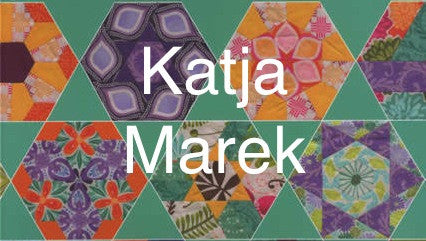
Featured Designer - Katja Marek
Share

As a busy mom on the go, I was delighted when I first learned about our Featured Designer for this month, Katja Marek, and her book The New Hexagon: 52 Blocks to English Paper Piece. She introduced modern techniques and tools along with projects, both big and small, that have helped make EPP popular again. I am personally enjoying rekindling my love affair with handwork and look forward to the possibilities that Katja continues to bring to the table.
Now, let's get to know Katja!
Jen: Where were you born and raised?
Katja: I was born in Moers (https://www.moers.de) in the Northern Rhine region of Germany. We lived there until two months before my 8th birthday. I had just finished grade two.
From Moers we moved to St. Catharines Ontario Canada (https://www.stcatharines.ca/en/). When we moved to Canada, we didn’t speak any English, so back into grade two I went. They did, however, make some concessions by putting me into a grade one English class and a grade five Math class for a while. By the end of grade three, I had caught up and went directly into grade five.
At 14, my family moved again to Parry Sound Ontario Canada, where my family bought a camp/resort, complete with housekeeping cottages and campground. This is where I completed high school and for the most part considered ‘home’.
Jen: How did you learn to quilt? Did you stitch as a girl? Any photos of your first quilt?
Katja: I have sewn as long as I can remember. I do not, however, remember ever being taught or learning to sew. My Mom was a tailor, and as I was growing up, she took in alterations in order to stay home with my sister and me. We visited daily in the sewing room, and I think that sewing came to me by osmosis...sewing and other handcrafts that is. I also crochet, cross-stitch and do some knitting. I always tell people that I grew up under my mother’s sewing machine. At 12, a neighbor asked me to sew doll clothing for dolls to be sold at a church rummage sale and, in exchange, I was able to keep one doll. I’ve also drawn much of my life, winning the Art Award in high school.
When we moved to that camp in Parry Sound, the cabin beds all had homemade coverlets on them. I fell in love with a traditionally set Grandmother’s Fan. I immediately set about making templates (read that as, very thick cardboard from the back of a sketchbook). I rifled through the scrap bins and cut up old clothing and leftovers from sewing my mom had done for others. The background fabric is a piece, probably poly/cotton that my Grandmother had sent from Germany.
I had sewn a lot but didn’t know much about seam allowances in quilting, and this quilt has everything from 1/8” to 1/2” seam allowance. I was aware enough to know that I had to trace around my templates and sew on the line. The quilt is an odd size at 53ish” x 87.5ish”, but fit my European twin very well.
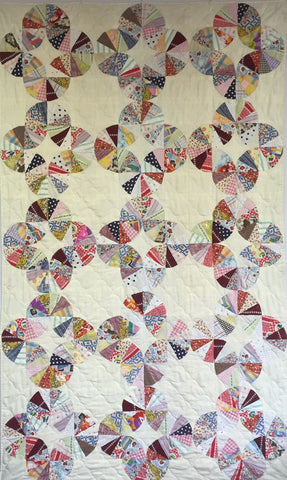
I call this quilt “My Seven Year Quilt”. Now this may lead you to believe that I made it in seven years, not so. I actually worked on it every seven years until I finished it at 35. I started it at 14 having just moved to the camp, worked on it again at 21 and newly married, again at 28 with young toddlers in the house, and finished at 35 when I was Guild President. I had a friend take it to the only long-arm quilter in the area at the time, and she was quite embarrassed to tell the woman that the president of the guild made this quilt.
I am very proud of this quilt that started my journey, and it is a true memory quilt. My only sibling, my sister, passed away in 1978, and this quilt is a journey through our childhood with the fabrics it contains.
The original coverlet that inspired me to make this quilt came back to me in the summer of 2014, 40 years later. My aunt and uncle who had stayed on at the camp after my family left, had kept many treasures from those day. As they prepared to move during 2014, they called to say they had a quilt from the camp days, and would I like it. I did not know until they arrived at my shop, that it was THE coverlet that started me on my journey so many years before.
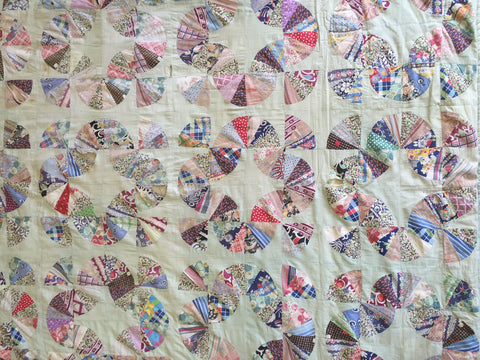
Jen: How and when did your passion for English Paper Piecing begin?
Katja: I actually balked at the idea of English Paper Piecing at the beginning. The year I was guild president (1995-96), we had a workshop in English Paper Piecing, and my thought was, why, when we have sewing machines and rotary cutters. After I opened my store, I hired Carla in May 2002, and Carla English Paper Pieced daily. Watching her became infectious, but it wasn’t until newer techniques (glue) made the process so much more doable that I really fell in over my head. I had a few projects on the go, like a 1” hexagon charm quilt, rose star blocks, Christmas ornaments which were all traditionally thread basted, but glue revolutionized my life.
Then the hexagon obsession hit me somewhere around 2009/2010, and I started dreaming of what I could do with hexagons, by breaking them down and designing inside them.
Jen: Complete this sentence, when I am not quilting or working in my quilt shop, I am...
Katja: …in my garden. I feel the need to have my hands in soil, to watch the flowers and bees, to eat something that I’ve grown. I currently live on the smallest property than I have my entire life, but it is still mine.
If I were able, I’d live by the water, and then you would find me at or near the waters edge.
‘I am at home in the garden, and my soul is soothed by the sea.’ – Katja Marek
Jen: How did your book, The New Hexagon, come to be? What inspired you to write it?
Katja: I started dreaming of the hexagon, specifically fractured hexagons where the possibility lay inside the hexagon, treating it as a block, not a unit in a quilt around 2010. I drew by hand, but decided I needed a more professional presentation. I set myself a task to use EQ to draw my blocks, and by 2011, I was ready to plan a program to run through my shop.
I started a Block-a-Week Hex-a-thon in January 2012, which turned out to be extremely popular. This was a pattern only Block-a-Week program. Our customers paid a commitment fee to sign up, and if they came in during the week the pattern was available, then they never paid again. They could not send in a proxy and had to pick up the pattern during the week that it was available or pay a small penalty of 50¢. Over the course of the year and all those 50¢ penalties, we raised $1,350.00 to donate to our local Hospice House.
A friend gave me the push I needed and encouraged me to write a book, to which I replied. 'No, I couldn’t do that'. The idea was firmly planted though, and I worked very hard to put a proposal together. I sent that proposal to Martingale at the end of July because I had a great working relationship with them for years, as their customer. In September, I had my contract in place.
Jen: You have named each of the 52 blocks in your book. Did you name them after women you know or did they take on personalities of their own?
Katja: When I first ran the 52 blocks as a Block-a-Week program through my shop in 2012, the blocks had no names. This program ended up being very successful and travelled far.
My business is largely a female based business, and I feel very blessed to be able to do what I love, day in and day out. When I received my contract from Martingale in September 2012, I was already 3/4 through the program and thought without the women that had participated and made it so successful, I wouldn’t have this book deal. I wanted to acknowledge some of those women by naming the blocks after them. I couldn’t use every name because there were too many, so I chose those women that had been the most faithful to the program.
Jen: How and when did you conceive the idea for The New Hexagon – Millefiore Quilt Along?
Katja: In the summer of 2012, I received a line of Kaffe Fassett fabric, which included a piece called 'Millefiore', which I fell in love with. I looked up the definition and thought perfect!
Millefiore is a glasswork technique, which produces distinctive decorative patterns on glassware. It is made by fusing multicolored glass canes together, cutting them crosswise, joining them into new groups and creating new, often kaleidoscopic designs. The term millefiore is a combination of the Italian words "mille" (thousand) and “fiore” (flower), plural "fiori" (flowers).
I loved the kaleidoscopic nature of this fabric, and knew I wanted to translate this into a quilt. Not just any quilt, but one based on the blocks in my book, to allow quilters another way to use these blocks. I loved the idea that this was much like the ancient glass caning technique of old, that by cutting and re-piecing the fabrics, I was creating new designs from identical units. These identical units are the fractured hexagons from my book, radiating outward from the center to form a rosette.
Rosettes are round, stylized flower designs and have been used in architecture and design for centuries. It derives its name from the natural circular shape formed by leaves radiating out from the stem of a plant, suggesting the petals of a rose and was often carved in stone, wood, or made of metal to create decorative elements.
I wanted a design of overlapping rosettes reminiscent of throwing pebbles into a pond. So I drafted a basic hexagon grid and overlaid concentric circles that would form the rosettes. It was important to me that each rosette be distinct and different from the others and this would be achieved by using the blocks from The New Hexagon, each already different and distinct, by nature of the shapes contained within.
Jen: Can you share with us your approach for choosing fabric for the Rosettes, both individually and how they play together within the quilt top?
Katja: I wanted my Millefiore quilt to be like an English country garden containing a riot of colors, with each of the large rosettes being a different color combination. I also look for lines within a fabric that will create flow within the blocks, and therefore the rosettes. Curves within a leaf or a paisley can create a soft rounded edge with my blocks and rosettes drawing the eye in, out or around the rosette as in Rosette 5. Contrast of color and value can give a sharp edge or division where desired. This is especially visible in Rosette 6 in the defined star. Around the edges of the quilt, the small partial rosettes, I tried to balance color within the quilt, by repeating colors I had used elsewhere in the quilt previously.
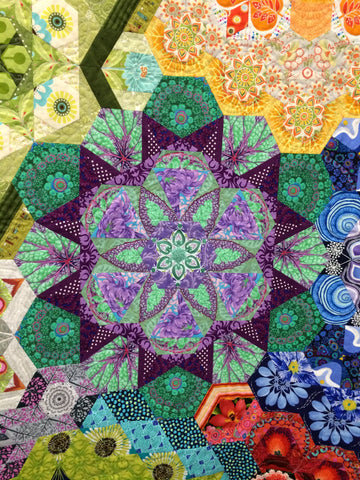
Jen: What inspired your latest quilt along, Blocks on the Go, for Quilts on the Grow?
Katja: With the end of The New Hexagon – Millefiore Quilt-Along approaching and its overwhelming success, I was asked by Martingale about what I had planned next. I had seen in the past several years how handwork had once again risen within the quilting community and decided to create a quilt-along that was truly 100% about handwork. A quilt-along where each block is also a finished ‘quilt-let’ and the project is ‘always done’! Once you have made one block, created its quilt-let and finished the quilting on it, you are finished! Completely! If you go on to make another block, turn it into a quilt-let and complete the quilting; you are again done. Sew it to the first completed block/quilt-let and again you are done. However far you go, you will always be done when the block is done. NO UFO’s! Throughout the program I give ideas for what combinations of different blocks can be if you go no further; however this is unlikely to happen, because these little quilt-lets are addicting.
Jen: With an international best seller, two quilt-alongs and a new perpetual calendar on the way, any other big plans for the year ahead?
Katja: When my book was released, I hoped for success having put my heart and soul into this project. But did I ever expect to have the number 1 book with Martingale for the entire 2015, absolutely not. Completing the book and running the first and starting the second quilt-along has not stopped me from coming up with more and more designs. To date, I have 806 fractured hexagon blocks in my database. I have gone from being unknown to being a recognized name by many in this wonderful industry. It has been a blessed journey through serendipity.
The New Hexagon Perpetual Calendar releases in July 2016 with a year full of new fractured hexagon blocks. I already have a 2017 quilt-along planned that will use blocks from the calendar. I will continue to release ideas for using the blocks from the book and calendar on my website.
I have been included as one of the designers for Pat Sloan and Jane Davidson’s The Splendid Sampler starting on February 14th and running as a 1 year long FREE online quilt-along that will culminate in a book through Martingale.
I have a full-time storefront shop in Kamloops, British Columbia, Canada and am trying to fit in more and more new teaching commitments so I am grateful for fabulous staff to pick up the slack when I am away. I have many, many ideas floating around in my head, and I continue to work with Martingale, so you may well see more ideas from me in the future.
In the meantime I am still ‘Discovering the ‘Hex’-abilities’ and invite you to join me.
I love Katja's story and look forward to seeing her new ideas! Have you started your EPP journey? Shop The New Hexagon collection at Red Thread Studio and start yours today.

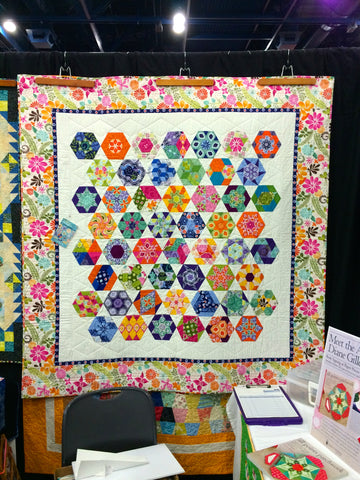

6 comments
I just love the book and am doing blocks in original size and also blocks on the go. Helped inspire a LQS to start an EPP club. Yesterday while there I mentioned the book and was told we need to reorder as we sold all our copies. Glad I have mine.
Something about this project has had me in its grips from the moment I saw it. Katja’s infectious smile maybe. But when I found out she was a fellow Canadian, my pride kicked in and I have never looked back. This is such beautiful interview and I go away loving her even more! So nice to see someone “living the dream”. GO, KATJA!
This Quilts on the go is an amazing project. Very inspiring to see the wonderful variety of blocks. Reading the likes & comments is like taking a worldwide journey! Thank you Katja ?❤️
I am so proud of you! I have known your for about 27 years and I still am impressed with how and what you do…day in and day out, you my dear are Amazing!
Congratulations Katjia. I have just finished making 52 hexes from your book and joined the FB groups for like minded EPP people and it is so much fun. Thank you well done.